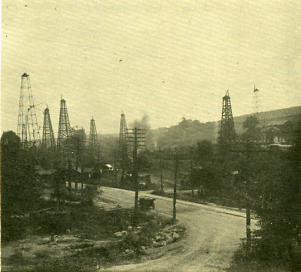
Wallace City oil boom.
Click Here to Return to Milestones
Drilling for crude oil began in Beaver County about 1880 on the Robert Wallace farm. The well, gushing crude oil, ran down the hill into the creek. This drilling excitement spread to adjoining acreages with some also sharing the fortune. When the Wallace well was finally contained, it flowed about 1400 barrels a day.
After E. L. Drake's well came in, in 1859 near Titusville, Pa., oil derricks were being raised all over the surrounding country side-some producing, others not. Finding places for oil storage in the field was a big and dangerous problem. At first the crude oil was contained in earthen pits; then large wooden tanks were built. Teams and wagons hauled barrels of oil to a railhead or a river bank for bulk movement of the crude to refineries.
Soon, however, oil production was exceeding well-head capacity so some enterprising oilmen had 2" wrought iron pipe made and laid 5 miles of it to a shipping point. They were astonished to learn that their little pipeline could transport more oil in 10 hours a day than 300 teams could haul it.
Before oil drilling commenced in Beaver County, a scummy substance was found oozing out of the shoreline of the Ohio River at Smith's Ferry. This oily stuff was collected by using cloths, then the oil was separated from the water. It was called Seneca Oil and was sold for medical uses. Lumbermill operators found this natural oil worked better then lard grease as a lubricant for their sawmill equipment. It was soon learned that by refining the heavy crude, it could be used for lighting and was used as fuel for lamps which had formerly burned whale oil.
W.B. (Crescent) worked in oil fields at Trinidad and Texas as a tool dresser. In those days they used a drop tool-a sharpened tool attached to a cable which was raised with a walking-beam, then dropped into the well hole to chip away the rock in the well. The old boilers and steam engines are now long gone also. Power is by natural gas, gasoline, diesel, and electric motors. For the last 50 or 60 years, rotary drilling has been done which has greatly increased oil production.
B.B. (Hopewell) started as a roustabout at 16, then fired boilers and later became a Beam Pumper, which pertains to vacuum line production of oil and gas. Vacuum plants ran natural gas through a compressor which converted gas to gasoline. The liquid was usually cooled by spring or creek water. He said "the five McDonald sands (or fields) produced 50 million barrels of crude oil in their first 10 years, making McDonald world-famous as an oil producer. Those fields were named Shannopin, McCurdy, Moon Run, Noblestown, and Venice."
J.E. (Moon) said that "Elmer Laughner made his big money a Gringo. Laughner owned numerous are oil wells or was in partnership. He was with Beck in Shannopin where they had an oil well supply store and also sold workmen's clothes there."
H.L. (Findlay) was a pumper. He said "in the earlier days two crews of two men worked 12 hour shifts; the driller got $6 and the tool dresser got $5 for their shifts. The machinery was steam driven, and the pumps in the creek had to keep the water up for the boilers. Harold's mother boarded oil crews in their 1893 house for 25 cents a day which included room, board, and washing."
The most notable production of crude oil took place in southern Hopewell Township at a place called Gringo, This place became an instant boom town as did the nearby shipping town of Shannopin.
In 1885 the Raccoon Oil Company was founded; drilling commenced on Alexander Morrow's property about 1885. Another nearby well on Marks' property struck oil first. After it was contained, its flow came in at about 3,500 barrels a day. Morrow sold his royalty for $3,000 and the new buyer sold it a few days later for $12,000. It is stated that the Gringo district drilled 69 wells.

The early sucker rods were made of hard, knotless wood such as hickory and southern willow. Split steel shanks which had internal and external threads to couple the 20' to 30' sections together were riveted through the wood. The lower end had a Standing Valve and a Traveling Valve which controlled the lift of the oil from the well. (We have two actual short length wooden and steel suckerrods at our Oil Well display.) B. B. advises "the present day sucker rods are made of steel and the Working Valve is at the bottom of the tubing (pipe), and there is a vacuum at the bottom of the hole. The vacuum is to pull the oil from the oil bearing sand which comes into the well tubing, and the gas escapes outside of the tubing."
Many other industries have started up in Beaver County in support of the discovery of oil and gas which have been economically beneficial. One branch business was the Armco Division of Spang Chalfant Company in Ambridge, which made both oil drill piping and steel sucker rods. An active business is the Valvoline Oil Company in Freedom, previously called Freedom Oil Works which was founded in 1879.
A local oil stripper advises that new oil well drilling is not being actively pursued because of stringent environmental and state and local regulations.